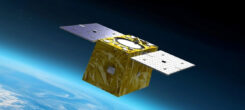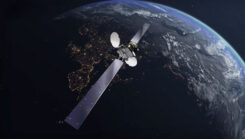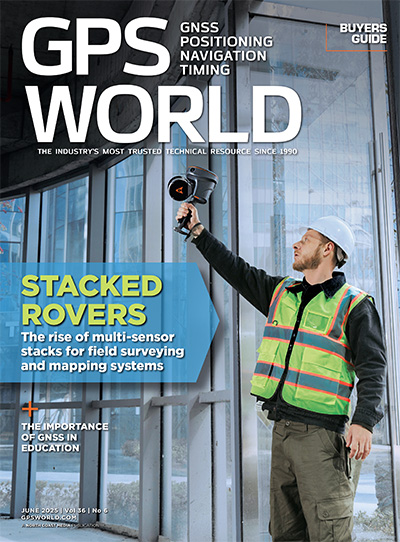From Definition To Development – and Beyond

 |
The positive decision taken on 5 April 2001 by the European Union’s (EU) Council of Transport Ministers, to proceed with the Development Phase of Galileo, was welcomed by all concerned, including the EU governments, the European Commission (EC), the European Space Agency (ESA), and European industry. It followed a joint EC/ESA publication on 13 February 2001, of a document entitled “Galileo Mission – High Level Definition.” This document, based on the work done during the Definition Phase in the year 2000, draws heavily on the conclusions of industrial contracts, such as the Galileo Overall Architecture Definition (GALA), Galileo Space and Ground Segment Definition (GALILEOSAT), Service Definition (GEMINUS), Search and Rescue (SARGAL), and INTEG, the Integration of the European Geostationary Navigation Overlay Service (EGNOS), as well as on the recommendations of several task forces (on Cost Benefit Analysis, Public Private Partnership, Frequencies, and Legal and Security Requirements).
This High Level Definition of Galileo envisages four categories of future services:
- 1. Open services, free to all users, providing positioning, navigation and timing, comparable to those of GPS
- 2. Commercial services, similar to the Open Services, but with added accuracy, coverage, and integrity, and hence with a liability regime
- 3. Public interest services, certifiable for safety-of-life transport and other safety-critical applications, complementing search-and-rescue operations, and helping with the implementation and enforcement of EU policies (for example, in fisheries)
- 4. Navigation-related communications; what is the good of knowing one’s position, if you cannot transmit this information to others?
Architecture and Funding
The High Level Definition document also provides a good summary of the system architecture, for both the global and local components of Galileo, the integration of EGNOS, safety and security considerations, interoperability with complementary systems (GPS, GLONASS, LORAN-C, Global System for Mobile Communications (GSM), and UMTS, and, critically, Public-Private-Partnership (PPP) issues.
The PPP vision recommended in this document is based on a Cost Benefit Analysis (CBA) that suggests not only projected commercial/industrial revenues from equipment sales and value added services, but also less tangible socio-economic benefits of more than E70 billion until the year 2020. This exceeds by an order of magnitude the projected cost of development, deployment and maintenance of Galileo, also through 2020, of E7 billion. Surely this makes Galileo a clear winner, and the Council of Ministers should have given an unambiguous “go ahead” signal earlier, in December 2000. This did not happen. The result was a postponement of the decision until 5 April 2001 when the EC received the partial green light to proceed.
Development
Why this hesitation? The main difficulty stems from the fact that the Development Phase, that is expected to run from 2001 to 2006 and estimated to cost about E1.4 billion, is almost completely funded by public financing. In contrast, the following Deployment Phase from 2006 to 2008 and costing E2.1 billion, is expected to be funded mainly by private financing, under a suitable PPP model.
The final Operations Phase will be completely self-funding from commercial revenues and service agreements, with governments also benefiting from the resulting taxation. Here lies the difficulty. Building and launching the space segment and setting up the ground infrastructure have to be paid up front, whereas the projected commercial revenues will only come onstream much later, and not necessarily to those companies and industrial sectors involved in setting up the Galileo system.
This is the dilemma facing the players involved. On the one hand, the European governments want industry to make a clear commitment, and not just a token one, to provide its share of the funding for the Deployment Phase, before they give the full, unambiguous “go ahead,”and release the required public funds. On the other, industry does not want or cannot commit the large amounts of private funding (risk capital) before certain specific actions take place. These include the launch of the Development Phase, a clear public funding commitment, a viable management structure for the project, the development of a robust business plan, and the putting in place of a selection process for the so-called Galileo Vehicle Company.
In capitalism, private companies cannot plan properly for longer than the next three to five years, let alone the next 20. Look at what happened to companies like Iridium and Globalstar, or those large European telecommunications companies who bid very large sums of money (enough to build several Galileos) for 3G UMTS licences. Governments, on the other hand, can plan and budget that far ahead, if they have the vision and are willing to accept some risk. Of course, in a democracy, governments do have to face the electorate every four or five years.
Looking Back
Let us stop here and visualise a meeting that, though fictional, must have happened about 30 or so years ago. Imagine Washington D.C., the Pentagon, a meeting involving several top Department of Defense (DoD) officials and the Treasury Department, chaired by the U.S. Vice-President, and discussing Project NAVSTAR, the precursor of GPS.
“We need the funds to develop NAVSTAR,” say the DoD representatives, “in order to replace the first generation Transit-Doppler system.”
“Can we afford it?” retort the Treasury officials. “Will it have non-military applications? Will it contribute to the U.S. economy?”
After a heated discussion, the meeting decides to carry out a Cost Benefit Analysis (familiar?), to see if the U.S. national security requirements could be met, while demonstrating some clear, distinct and measurable non-military benefits to the United States. Senior consultants carry out this CBA, and bring their conclusions to a subsequent meeting, this time in the Treasury.
The arguments are clear and decisive. NAVSTAR cannot be used for civil aviation, because it does not meet the strict requirements fulfilled by VOR/DME equipment, the recent developments in Inertial Navigation (INS),and the upcoming Instrument Landing System (ILS). Similar arguments are put forward in the case of marine navigation. They are perfectly happy with the LORAN-C developments, the new Omega system, and the odd sextant measurements to the sun and stars.
How about the environment? Can NAVSTAR help the new Earth Observation satellites? Not really! So, gentlemen, what will our decision be? “Well,” says the Chairman, “we appreciate all these economic arguments, but Transit-Doppler alone cannot fulfil our global military mission requirements. It takes about 30 minutes to get a fix with a reasonable positioning accuracy,” (as was amply demonstrated later in the 1982 Falklands conflict). “We need a proven satellite navigation system which will provide the necessary force enhancement. We shall proceed with the NAVSTAR Program because our forces and NATO need it.”
“Gentlemen,” says the Vice-President, “the meeting is closed.”
So what has NAVSTAR-GPS done for the United States (and the rest of us) over the last 20 years? Hundreds of civilian applications have been developed, in science (crustal dynamics, sea level height monitoring, meteorology, high precision timing), in engineering (off-shore exploration, structural monitoring of dams), in civil aviation, in marine navigation, fishing, land transportation (traffic monitoring), security, the elderly, the blind, emergency situations, mapping and surveying. Has the United States benefited from GPS? Yes, industrially, economically (through VAT and corporation tax), from the environmental point of view, and in terms of political influence. I cannot think of many other U.S. public or private investments that have produced so many benefits not just for the United States, but also for mankind. OK, except the Internet, Bill Gates and Microsoft.
Here we are discussing, “should or should not Europe proceed with an apparently more advanced satellite navigation system than the current GPS, at an estimated cost of between E4 and E7 billion (Beuros) over the next 20 years?” We have carried out several CBAs, several PPP models have been proposed, and still we hesitate. Don’t you wish that the EC and the EU Councils of Ministers hesitated half as much when discussing some other expenditure proposals, on projects which have gone on for years?
Deployment
Let us now look forward to the year 2010. GPS III (whatever it may be) and Galileo operate happily together. They have compatibility and interoperability. We no longer talk of (let alone make a fuss about) Galileo or GPS, but simply refer to SatNav or SatPos.
Chips, which enable measurements to all the available satellite systems (Galileo, GPS, GLONASS, Inmarsat) are embedded in a very wide range of infomobility consumer equipment, be it palmtops, mobile phones, vehicles, fixed appliances (registering when they are moved, either to a new house or by a thief), natural (earthquakes, floods) or manmade (regional conflicts, refugees) disaster monitoring devices, all of us (monitored by the boss at work or at home), briefly, chips embedded in everything. We don’t talk about these devices or who makes them any more than we talk about wrist watches today, but we use them and they govern our lives.
What about security? Can we prevent terrorists from buying wrist watches? Or books to manufacture a bomb? There will always be other ways of handling this threat.
What about GPS III? What are the Americans planning? Could it affect Galileo? Will it trump the Galileo system and render it obsolete? Could the Americans really do this?
They could, if they thought that U.S. survival depended on it, or in a cold war situation where they had to demonstrate their technological superiority. This is not the case!
Back to the present, all the United States has done so far has been to award two relatively small contracts to Boeing and to Lockheed Martin for predefinition ideas on GPS III, on the understanding that the winning consortium may receive the first GPS III Definition Phase contract.
The Foreseeable Future
Undoubtedly, the European Union’s decision to proceed with Galileo has already led to tangible benefits. Selective Availability is off. The head of NASA announced this during GNSS-2000 in Edinburgh, for maximum effect. And the U.S. policy of “no user fees” for the basic civil and safety-of-life services, and of open signal specifications, will remain in effect “for the foreseeable future,” according to Joe Canny, the Deputy Assistant Secretary at the U.S. Department of Transportation. Furthermore, U.S. industry and commerce are eager to exploit the added benefits that Galileo would bring, and are pressing their own government to negotiate a deal with the EU to make Galileo fully compatible and interoperable with GPS.
This is not a cold war situation, with the two systems, GPS and Galileo, competing for supremacy. A tactful acknowledgement that Europe, as with the rest of the world, has benefited substantially from free access to the GPS signal for over 20 years, and may continue to do so at least until 2008, should facilitate an agreement for compatibility and interoperability, without losing any sovereignty over the deployment, operation and maintenance of either GPS or Galileo.
Consider an intermediate period of time for the Galileo project, the years 2006–2007, when the Development Phase has just ended, and the first 10 or so Galileo satellites have been deployed. These satellites already provide a welcome augmentation to GPS, improving availability, coverage, and accuracy, as well as providing a small but independent source of integrity, just like EGNOS and WAAS. Several chip manufacturers have already seized on this early opportunity, and are helping manufacture dual GPS-Galileo receivers, even though these involve the payment of, say, E1 tax for each such receiver. Some manufacturers have already developed new properties or functions for the combined GPS-Galileo chips. Outdoors-indoors continuous navigation and positioning, perhaps with the addition of an inexpensive INS component, perhaps without it, by using some other clever way of indoor navigation with Galileo. Who knows?
The Next Generation
Let us now take a much longer-term look. What happens, say, between 2015 and 2020? Will the Galileo system continue for many more years to make large profits for the private sector and bring substantial revenues to European governments? Maybe yes, or maybe not. In 2001 we already discuss microsatellites, nanosatellites, and formation flying. These technologies have already reached the point where GPS was 25 years ago. But these developments will mature even faster, and new concepts of satellite navigation and positioning will certainly evolve. You do not need to be a mathematical genius or a financial prodigy to realise that, just as GEO satellites have given way to MEO satellites, these in turn will give way to micro- and nanosatellites in LEO orbits. The latter are cheaper to manufacture and launch, and much easier to maintain and replace. This is another reason why Europe must continue to be involved not just in Galileo, but in the whole discipline of sat-nav technology.
Well before 2020, we shall be talking of plans for the next generation of the European satellite navigation system, apr籠Galileo. We may again go to our Italian colleagues and ask for another name of an historical personality, maybe another scientist or perhaps a famous explorer. If they run out of names, we shall turn to our Spanish colleagues. They could suggest a Spanish explorer, with a typically Spanish name, “Cristobal Colon,” also known as Cristoforo Colombo, or just plain Columbus.
May 8, 2001. The Development Phase of the Galileo Project will take place between 2001 and 2006. The resolution of the EU ministers foresees two stages. In the first one, just begun, funds will be released immediately to allow the EC to publish a call for proposals to study, among other items, the type of services to be offered by Galileo and the corresponding flow of revenues from them. The key question is not “what Galileo can do,” but “what Galileo plus GPS can do” when the two systems are up and running together. The conclusions of these studies will be submitted in December 2001 to the Council of Ministers, who would then confirm the second and final stage of the Development Phase, and release all the public funds earmarked for the Galileo Project. The ministers would also (and this is crucial) insist on a commitment that no additional public funds will be required, other than those earmarked, when Galileo moves to the deployment and operational phase in 2006.
This long overdue agreement was made easier to achieve by the unexpected announcement that the private sector is willing to commit E200 million to the Galileo Development Phase, augmenting the E1.2 billion of public funding from the EU and ESA.
In the subsequent Deployment Phase, public sector funding from EU and ESA is predicted to go no higher than E600 million, with the private sector providing the lion’s share of the total, estimated to reach E2.1 billion. We shall see.
;

















Follow Us